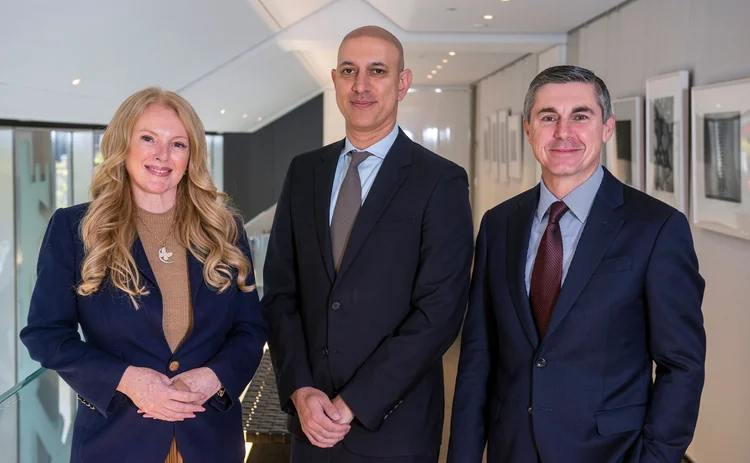
Derivatives house of the year: UBS
Risk Awards 2025: Mega-merger expected to add $1 billion to markets revenues, via 30 integration projects

One weekend last March, top executives at UBS’s investment bank gathered to discuss the impending merger with Credit Suisse.
Expectations were at best cautious. The prevailing view among attendees was that there wasn’t much scope for integration.
“All the [pre-merger] analysis suggested there was a lot of overlap. Initially, we didn’t think we’d have very much to integrate on the markets side at all,” says Jason Barron, head of global markets at UBS.
Fast forward to today and the mood could not be more different.
“This is a new UBS,” Barron says of the combined business. “This isn’t just UBS with a few new people. Some of the capabilities are materially improved.”
UBS’s latest earnings provide a glimpse of the transformation.
The investment bank posted year-over-year revenue gains of 29% in the third quarter of 2024, with global markets up 31% and derivatives and solutions ahead 43%.
Barron and others say there is more to come. The markets business is currently pursuing around 30 different initiatives linked to the merger that the bank expects to generate around $1 billion of additional revenue. More than half of those gains are on track for this year, with the rest expected to come in 2025.
The opportunity to grow and continue to capture market share is stronger now than it has ever been
Dushyant Chadha
The early returns have been more than encouraging.
In equity derivatives, UBS now claims to rank first in market share for listed options globally, and second in Eurostoxx options, with volumes doubling.
The structured products business has been on a roll, with year-over-year growth of 100%.
In fixed income, UBS is now the top issuer on Spire, the multi-dealer structured note platform, with $1.2 billion notional of repacks issued in the first half of 2024 alone.
The FX derivatives unit, already a powerhouse, saw volumes increase 25% year-over-year.
A ‘win-back’ campaign launched last December has secured renewed business from more than 200 former Credit Suisse clients.
Dushyant Chadha, global head of derivatives and solutions at UBS, already views the merger as a triumph for his unit. “I would say, without reservation, at this moment in time, I think we have the strongest platform we have ever had,” he says. “The opportunity to grow and continue to capture market share is stronger now than it has ever been.”
Barron is also excited about what’s still to come. The biggest opportunity he sees is in corporate derivatives, where UBS has struggled since its retreat from deal-making in 2012. The addition of Credit Suisse’s investment bankers should rejuvenate that business. The merger also opened new markets, particularly in Latin America and the Middle East, where UBS was weak or absent before. It now has an equity derivatives team in Brazil, an Islamic finance operation in Saudi Arabia and an insurance solutions business in Japan. In the US, the merger allowed UBS to re-enter the convertible bonds business and add a highly rated loan trading team, accelerating its effort to bulk up in credit trading by as much as five years.
The new businesses, such as corporate derivatives and Japanese insurance solutions, are expected to start contributing material revenues in 2015. The units that have already seen a boost – notably equity derivatives and fixed income solutions – should also kick into another gear as senior staff wrap up integration projects and new staff get up to speed.
“People are just coming off fairly heavy integration work,” says Barron. “We’ve had people, very skilled people – structurers, quants, traders, salespeople – who have been working with clients and doing novations. They’re now coming back online. That’s quite exciting.”
The excitement is backed by a newfound conviction that the new UBS can now go toe-to-toe with the largest derivatives dealers. There is “some real confidence in the business,” says Barron. “People genuinely believe this is not the UBS of old. Certainly, if you ask people at UBS now, they won’t say that we’re second tier to anyone.”
Inside man
The early doubts began to lift when Barron and his team began speaking with Mike Ebert, who at the time was co-head of markets at Credit Suisse, and now heads UBS’s investment bank in the Americas.
UBS executives had limited access to information about Credit Suisse’s operations in the weeks after the deal was announced. A select few were given access to a data room where they could get a glimpse under the hood. Ebert served as the main touchpoint for any other questions. Starting in March, he led a series of deep dives with senior executives at UBS, including investment bank co-president Rob Karofsky and the co-heads of markets, Barron and George Athanasopoulos.
Ebert knew the business inside-out having led an internal review of Credit Suisse’s investment banking activities after the Archegos debacle in 2021. “We had already analysed the business so intensely in order to optimise capital and plan for a new strategy,” he says. Large chunks of the portfolio – from structured mortgages to long-dated exotic derivatives – had already been placed in Credit Suisse’s non-core unit and were being sold or rolled-off. Ebert directed the UBS team’s attention to the best of what remained.

“Mike and the team were very quick to say, ‘Well, this is a real gem in our franchise; these are the returns we’re getting from these businesses; these are our clients; have you thought about this?’,” says Barron. “They had spent a lot of time going through the portfolio and had thought about the many different ways it could be run.”
As the UBS executives started digging into the details, “a light bulb went off and we saw there was meaningful opportunity within the CS business,” says Barron. “Quite quickly, we realised there were a number of business lines that were of interest.”
The merger of the holding companies of UBS and Credit Suisse formally closed on June 12, 2023. By then, the broad contours of the integration plan for the markets businesses were largely set.
There were three priorities. The first was to retool the fixed income business, which UBS had effectively retreated from in 2012 in an effort to boost the investment bank’s profitability. It came to regret that decision when the markets became a lot more macro-focused in the aftermath of the Covid-19 pandemic.
One of the best decisions we made, which we were adamant about from the start – and it wasn’t really a controversial decision – was that we weren’t going to take any CS technology
Jason Barron
“We realised back in 2020 that we needed a more balanced global markets business,” says Barron. “We needed to rebuild in some of the foreign exchange, rates and credit products which suited our existing strategy.”
The second priority was to position the corporate derivatives business to benefit from the arrival of Credit Suisse’s investment bankers. “You need the bankers to be able to win those deals,” says Barron. “UBS didn’t have the quality of those banking relationships and possibly even on the markets side the ability to pitch to our own bankers.”
The third big call was perhaps the easiest. “One of the best decisions we made, which we were adamant about from the start – and it wasn’t really a controversial decision – was that we weren’t going to take any CS technology,” says Barron. “We weren’t going to move any physical systems.”
The thinking was simple. “If you want to be out in front of clients selling products and building businesses at any point in the next three to five years, you certainly don’t want to be going through a systems integration,” says Barron.
That might have been the extent of the merger for the markets business. As it turned out, it was just the beginning.
Open sesame
After the holding company merger in June 2023, some of the more onerous restrictions on information sharing were loosened, allowing UBS’s trading and structuring teams to take a closer look at Credit Suisse’s portfolios. They quickly uncovered a wealth of additional opportunities.
A process was created to allow individual business lines to make the case for migrating specific portfolios or businesses. The proposals were brought to a global markets integration committee, which sent the best ideas to a committee at the investment bank level for approval.
By now, the potential benefits of the investment banking integration were widely recognised within UBS. “The biggest upside was clearly on the wealth side of the business, but in the investment bank, people realised that actually there’s value here because some of our flagship businesses are scale businesses, and having a little bit more scale makes a big difference,” says Barron.
In all, UBS’s derivatives businesses got approval to migrate more than $60 billion of positions from Credit Suisse.
That included around $13 billion of equity derivatives positions, across flow and exotics, along with $18 billion in QIS products – more than doubling the number of indexes offered to UBS clients.
We’re probably five years ahead of where we would have been [in credit trading] if we had done all this organically
Jason Barron
On the fixed income side, north of $22 billion of credit solutions – including 800 repacks, 450 self-issued notes and over 1,000 client-facing positions – were transferred from Credit Suisse, in addition to more than $7 billion in corporate derivatives trades.
The scale of the migrating positions created fresh demands. UBS had to replicate a number of Credit Suisse’s quantitative models and execution algorithms to support the new portfolios and positions it was managing. It did so while holding firm to the principle that it wouldn’t migrate any systems.
“We brought over a lot of tech people, and that meant we could build what CS had into our systems, and even improve on it,” says Barron. “We had lots of new models come over and we’ve taken more risk, but we made sure we were very much within our risk appetites.”
For many business heads, the biggest need was people, not positions. UBS’s flow equity derivatives desk – like many of its peers – had lost several senior executives to hedge funds in 2022 and was struggling to replace them. Since the acquisition, equity derivatives headcount across sales, trading and structuring is up 20%. The fixed income solutions team, which had been undermanned for years, more than doubled in size.
We knew we had to stay aligned to our strategy and that was a guiding principle
Jason Barron
The timing was perfect for Andrew Goldman, who had joined UBS from Goldman Sachs to run credit trading in October 2022. He spent the next six months assessing UBS’s capabilities, and was just preparing to make a series of new hires and systems upgrades when the acquisition happened. In the space of a few months, he was able to bolster the sales and risk teams, onboard a raft of new clients, secure IT resources to handle systems upgrades, and even bolt on a loan trading team. “We’re probably five years ahead of where we would have been [in credit trading] if we had done all this organically,” says Barron.
There were many more stories of a similar vein across the markets division. “There are so many areas where we were able to say, we’re absolutely not changing our risk appetite or strategy, but there’s lots of opportunity here,” says Barron. “Sometimes it’s an exceptional person, sometimes it’s a new product line, sometimes it’s a piece of technology – we were very thoughtful and selective in how we looked at this.”
And sometimes, it was an entire business line. One example was Credit Suisse’s Japanese insurance solutions business, which specialises in liability hedging – a bespoke service that commands by far the biggest wallet share with local lifers, but for which there are few credible providers. UBS had looked at entering this market multiple times in the past and decided the technological and regulatory barriers were too high. Credit Suisse was an early mover, establishing a Bermudan subsidiary called Boston Re in 2000 to provide reinsurance services – including hedging of individual policy cashflow streams – to Japanese life insurers.
Boston Re is one of only four investment bank-owned Bermudan reinsurers active in Japan and was well-positioned in the market. Barron wasn’t about to look a gift horse in the mouth.
“The Japan reinsurance business, realistically, we were nowhere, and it looked like a reasonably heavy infrastructure lift just to participate, so to be honest I don’t think we ever would have bitten from that apple [if not for the merger],” says Barron.
The bulk of the integration plan – including the migration of people, positions and businesses – was formulated between June and September of 2023. Not long after, the bank’s group CEO, Sergio Ermotti, called time on the merger planning and attention shifted to execution.
“There were a few conversations where I had to tell people, don’t have eyes bigger than your plate,” says Barron. “We wanted to be in front of clients, growing the business. There were so many opportunities, there were so many new initiatives, and I didn’t want us to be bogged down in complex migrations and moving special purpose vehicles. We knew we had to stay aligned to our strategy and that was a guiding principle.”
Every department head has seen a tangible benefit to their business
Dushyant Chadha
Credit Suisse’s traders moved quickly to package up the portfolios that were moving to UBS and upload files with transaction details to shared sites. On the UBS side, every transaction was treated as if it was a new trade with an external counterparty, with a product control group overseeing valuations.
This could have been a bottleneck. Each portfolio transfer required sign-offs from 20 or so different groups – from risk to finance – but the call not to get bogged down had been heard. “We were able to get all of those 20 approvals done in a day in many cases, often within an hour,” says Barron.
The vast majority of positions were migrated before the next major milestone – the merging of the main parent companies of Credit Suisse and UBS on May 31, 2024. In cash equities, for instance, all clients and positions were onboarded by the end of 2023. As of October 2024, around 90% of the migration work was complete.
Barron also praises former Credit Suisse staff for pitching in with the integration, even if they had no real expectation of getting a new role at UBS. “These people were amazing citizens,” he says. “They spent a lot of time getting colleagues that were moving or UBS people up to speed – and I’m not just talking about traders, I’m talking about second line people, ops people, technology people.”
(Much) more to come?
The merger has transformed UBS’s investment bank in both expected and surprising ways.
The rejuvenation of the fixed income business, with the solutions team doubling in size and the expansion in credit and loan trading, falls into the former category.
“The structured fixed income business for institutional clients was something that we really wanted to grow,” says Barron. “The number one ranking on Spire is just immense when it comes to being in front of that client base.”
Having a fully fledged solutions business, coupled with targeted additions to the flow and exotics desks, has also rounded out UBS’s overall derivatives offering. “On the rates derivatives side, we are meaningfully more relevant, certainly than where we were before,” says Chadha.
Or as Barron puts it, “we went from under critical mass to through critical mass in a positive way”.
The ramp-up in corporate derivatives is also going according to plan. “It feels like that business is double the size it was before,” says Barron. While UBS previously stuck to providing margin loans and collars to corporates, the integration of Credit Suisse’s bankers and sales teams has allowed it to capture a lot more flow business from this client base, in addition to competing for corporate FX, deal contingents and bridging loans.
We’ve all been so pleasantly surprised that there’s upside coming from so many different areas
Jason Barron
“That’s also a big benefit to our FX business, seeing these flows,” says Barron. “People talk about the multiplier effect of a prime brokerage business, but a corporate business has a similar multiplier effect in FX.”
The FX business has also benefited from access to Credit Suisse’s roster of ultra-high-net-worth clients, who now rely on UBS for liquidity.
That was expected. The bigger surprise was in equity derivatives, where expectations were low. Here, the starting point was that UBS would take very little – if anything – from Credit Suisse. The business had to argue the case for every portfolio or person it wanted to migrate. As it turned out, while the fixed income solutions team doubled in size, equity derivatives saw the biggest headcount increase in absolute terms.
“I’ve been more surprised by it, possibly,” Barron says of the impact the merger has had on the equity derivatives business. “Rates and credit were areas where we know there was a lot of upside. But the quality of people that have joined in equity derivatives has been super high. The diversity of thought, entrepreneurial spirit and culture of innovation that CS has is making a big difference.”
UBS’s derivatives businesses are also benefiting from other adjacencies, such as the integration of Credit Suisse’s US convertible bonds business, which UBS exited after the 2008 financial crisis. “Being able to bolt that back on is very important to our derivatives business,” says Barron. “It’s not just about winning those transactions, which can be meaningful in their own right, but it’s all of the risk recycling and the fact that hedge funds want to talk to you about those transactions.”
There are similar synergies across corporate derivatives, loan trading and other business lines that have either been added or grown as a result of the integration. “One of the reasons everyone is so enthusiastic is because we’ve all been so pleasantly surprised that there’s upside coming from so many different areas, and also the connectivity that you get,” says Barron. “We might be speaking to someone in US loans and that person might also trade equity derivatives, and we get a referral. There’s upside in things we couldn’t possibly plan for.”
Perhaps the hardest question to answer these days is which part of the derivatives business has benefited most from the merger. “If you ask the business line owners, I think each of them would genuinely say it’s been good for them,” says Chadha. “And that’s the beauty of the way we have run the strategy. Every department head has seen a tangible benefit to their business. They all feel like they have come out of this with a wider product offering, a better client base, and dialled in for more success for their business going forward than if the merger did not happen.”
That message seems to have reached the highest echelons of the bank. In recent investor presentations, Ermotti and chief financial officer Todd Tuckner have suggested the investment bank could be among the company’s fastest growing divisions – a far cry from the days when wealth management was seen as the only game in town for UBS
Can the investment bank live up to expectations?
“We’re certainly up to the challenge,” says Barron. “There’s a huge amount of upside.”
Only users who have a paid subscription or are part of a corporate subscription are able to print or copy content.
To access these options, along with all other subscription benefits, please contact info@risk.net or view our subscription options here: http://subscriptions.risk.net/subscribe
You are currently unable to print this content. Please contact info@risk.net to find out more.
You are currently unable to copy this content. Please contact info@risk.net to find out more.
Copyright Infopro Digital Limited. All rights reserved.
As outlined in our terms and conditions, https://www.infopro-digital.com/terms-and-conditions/subscriptions/ (point 2.4), printing is limited to a single copy.
If you would like to purchase additional rights please email info@risk.net
Copyright Infopro Digital Limited. All rights reserved.
You may share this content using our article tools. As outlined in our terms and conditions, https://www.infopro-digital.com/terms-and-conditions/subscriptions/ (clause 2.4), an Authorised User may only make one copy of the materials for their own personal use. You must also comply with the restrictions in clause 2.5.
If you would like to purchase additional rights please email info@risk.net
More on Awards
Clearing house of the year: LCH
Risk Awards 2025: LCH outshines rivals in its commitment to innovation and co-operation with clearing members
Best use of machine learning/AI: CompatibL
CompatibL won Best use of machine learning/AI at the 2025 Risk Markets Technology Awards for its use of LLMs for automated trade entry, redefining speed and reliability in what-if analytics
Markets Technology Awards 2025 winners’ review
Vendors jockeying for position in this year’s MTAs, as banks and regulators take aim at counterparty blind spots
Equity derivatives house of the year: Bank of America
Risk Awards 2025: Bank gains plaudits – and profits – with enhanced product range, including new variants of short-vol structures and equity dispersion
Law firm of the year: Linklaters
Risk Awards 2025: Law firm’s work helped buttress markets for credit derivatives, clearing and digital assets
Interest rate derivatives house of the year: JP Morgan
Risk Awards 2025: Steepener hedges and Spire novations helped clients navigate shifting rates regime
Currency derivatives house of the year: UBS
Risk Awards 2025: Access to wealth management client base helped Swiss bank to recycle volatility and provide accurate pricing for a range of FX structures
Inflation derivatives house of the year: Natixis
Risk Awards 2025: French bank’s hedge fund push boosts its flow standing and creates repack risk offsets









